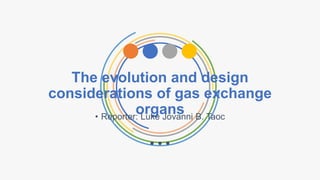
The Evolution and Design of Gas Exchange Organs
- 1. The evolution and design considerations of gas exchange organs • Reporter: Luke Jovanni B. Taoc
- 2. Functional requirements 2 • It is apparent that gas exchange across the body surface will only meet the requirements of small animals or those with very low metabolic rates. • Before the organs themselves are discussed, it is necessary to appreciate the functional requirements of such organs
- 3. 1. A large surface area To simply increases the amount of gas that can be moved from the environment to the animal and vice versa. The rate of gas exchange greatly depends on the size of an animal, and then consequently the surface area to volume ratio, because as an animal gets larger, the volume increases much more than the surface area. This will affect the way in which an animal exchange gases: smaller animals can do so mainly via diffusion, whereas larger animals need to rely on respiratory organs. For example, the shape of the alveoli inside the lungs has a large surface area. 3
- 4. 2. Minimal Separation The separation between the blood of the animal and the air or water it breathes must be minimal. Most gas exchange surfaces are extremely thin (sometimes just one cell thick), ensuring a short diffusion pathway across the exchange surface. They will also have a large surface area to volume ratio which provides more space for the diffusion of gases. The alveoli wall (and the capillary wall) is only one cell thick so there is only a short distance over which diffusion takes place (short diffusion pathway) so there is a faster rate of diffusion of oxygen from alveoli into the blood. 4
- 5. 3. Appropriate ventilation:perfusion ratio The movement of the respiratory medium must match that of the body fluids (into or out of which the gases move) to give the appropriate ventilation:perfusion ratio. For the lungs to function effectively, they need to be both ventilated and perfused and it is therefore necessary to have the correct ventilation:perfusion ratio. A lung that is ventilated, but receives no blood supply will not be an effective gas exchange organ. In this case, there is an extreme mismatch of the ventilation:perfusion ratio. 5
- 6. WHAT IS VENTILATION:PERFUSION RATIO? 6 V/P RATIO • The ventilation rate (V) refers to the volume of gas inhaled and exhaled from the lungs in a given time period, usually a minute. This is calculated by multiplying the tidal volume (volume of air inhaled and exhaled in a single breath) by the respiratory rate. In an average man, the ventilation rate is roughly 6L/min. • The perfusion (Q) of the lungs refers to the total volume of blood reaching the pulmonary capillaries in a given time period.
- 7. 4. Physical Arrangement The final aspect of the design of gas exchange organs is the physical arrangement between the respiratory medium and the body fluids. 7
- 8. Uniform Pool Arrangement 1st Physical Arrangement • In this situation, the respiratory medium (i.e. air) does not flow in any particular direction in relation to the flow of blood through the lungs. An equilibrium is established between gas concentrations in air and blood 8
- 9. Countercurrent arrangement, as seen in fish gills. 2nd Physical Arrangement • Here, the flow of the respiratory medium (i.e. water) and blood are in opposite directions. This is a particularly good arrangement, in that the entire length of the gas exchange surface is utilized. At any point along the gill, gas concentration in the water is greater than that in the blood, so there is continual movement of gas from water to blood 9
- 10. Concurrent arrangement where the respiratory media and blood flow in the same direction. 3rd Physical Arrangement • Such a system is less efficient. Maximal theoretical gas concentrations in the blood are never achieved because gas concentrations equilibrate before blood has had a chance to perfuse the entire length of the respiratory organ 10
- 11. Crosscurrent flow 4th Physical Arrangement • This is the arrangement found in bird lungs. Here, blood and respiratory medium flow almost at right angles to each other. Once again, this ensures maximal transfer of gases between blood and the respiratory medium. 11
- 12. Three Possibilities • Bearing in mind all the requirement of gas exchange organs, evolution has provided animals with three possibilities: gills, tracheal and lungs systems. 12
- 13. GILLS 13 • They are outgrowths of the body surface • They may be secondarily enclosed in the opercular cavity in bony fish. • In order for them to be ventilated, water must pass over their surface. This can be achieved in one of two ways: either the gill passes through water or water passes over the gill. • The latter is only feasible for small organisms (e.g. some aquatic insect larvae) • Gills are present in both invertebrates and vertebrates. GAS EXCHANGE ORGAN FOR AQUATIC ANIMALS
- 14. TRACHEAL SYSTEMS 14 • Gas exchange in insects occurs through a series of tubes called trachea, which branch dichotomously to give increasingly finer tubes called tracheoles. GAS EXCHANGE ORGAN FOR INSECTS
- 15. TRACHEAL SYSTEMS • In principle, air is piped directly to the cells of the insect. • This arrangement makes the respiratory system independent of the circulatory system. • Generally, all the trachea interconnect with each other. • unidirectional flow of air throughout the animal. • Spiracles Trachea Tracheole cell Tracheole 15